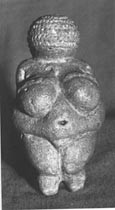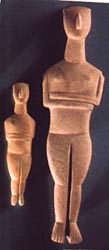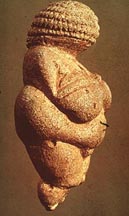The [Female] Nude
Johann Zoffany, The Tribuna of the Uffizi, 1772-78
The [Female] Nude
Johann Zoffany, The Tribuna of the Uffizi, 1772-78
Lynda Nead, The Female Nude, p. 1: Anyone who examines the history of western art must be struck by the prevalence of images of the female body. More than any other subject, the female nude connotes 'Art'. The framed image of a female body, hung on the wall of an art gallery, is shorthand for art more generally; it is an icon of western culture, a symbol of civilization and accomplishment. But how and why did the female body displayed in the gallery relate to other images of the female body produced within mass culture? These are the types of questions that are addressed in the following pages.
Guerilla Girls, 1989.
Compare the Tribune of the Ufizzi to the following interview with Tom Hunter about his photographs in the National Gallery of Art
p. 11: Woman looks at herself in the mirror; her identity is
framed by the abundance of images that define femininity [see
the Social Construction of Gender].
She is framed --experiences herself as image or representation--
by the edges of the mirror then judges the boundaries of her own
form and carries out any necessary self-regulation.
p.18: ...[I]f art is defined as the conversion of matter into
form, imagine how much greater the triumph for art if it is the
female body that is thus transformed --pure nature transmuted,
through the forms of art, into pure culture.
p. 25: The female nude is the border ... between art and obscenity.
The female body --natural, unstructured-- represents something
that is outside the proper field of art and aesthetic judgement;
but artistic style, pictorial form, contains regulates the body
and renders it an object of beauty, suitable for art and aesthetic
judgement.
p. 56: ...Within this metaphorical structure, the canvas is the
empty but receptive surface; empty of meaning --naked-- until
it is inscribed and given meaning by the artist. Kandinsky's statement
of 1913 is a particularly vivid example of this feminization of
the canvas/surface:
"Thus I learned to battle with the canvas, to come to know
it as a being resisting my wish (dream), and to bend it forcibly
to this wish. At first it stands there like a pure chaste virgin...And
then comes the wilful brush which first here, then there, gradually
conquers it with all the energy peculiar to it, like a European
colonist."
In this astonishing combination of contemporary sexual and colonial
ideologies, Kandinsky evokes the practice of painting as a rape
scene, a violation of the female body/canvas which he then compares
to the forceful subordination of a colonized subject by the colonizing
power.
Griselda Pollock, Differencing the Canon, p. 30: The signifiers Man and Woman... mark spaces in a continuum of meanings that depend upon the whole system for the values that are attributed to these particular terms. Woman belongs in a set that includes nature, body, passivity, victim, lethal sex, timelessness and so forth, while Man relates to notions of mind, the social, the rational, the historical, activity, authority, agency, self-determination etc.
T.J. Clark, The Painting of Modern Life, Princeton, 1984, p. 131: A nude...is a picture for men to look at, in which Woman is constructed as an object of somebody else's desire.

|

|
|
|
|
Kenneth Clark, The Nude, p. 109: Plato, in his Symposium, makes one of the guests assert that there are two Aphrodites, whom he calls Celestial and Vulgar, or, to give them their later titles, Venus Coelestis and Venus Naturalis; and because it symbolized a deep-seated human feeling, this passing allusion was never forgotten. It became an axiom of medieval and Renaissance philosophy. It is the justification of the female nude. Since the earliest times the obsessive, unreasonable nature of physical desire has sought relief in images, and to give these images a form by which Venus may cease to be vulgar and become celestial has been one of the recurring aims of European art. The means employed have been symmetry, measurement, and the principle of subordination, all refining upon the personal affections of individual artists. But perhaps this purification of Venus could not have taken place had not some abstract notion of the female body been present in the Mediterranean mind from the first. Prehistoric images of women are of two kinds, the bulging statuettes from paleolithic caves (figure 2), which emphasize the female attributes till they are little more than symbols of fertility, and the marble dolls of the Cyclades (figure 3), in which already the unruly human body has undergone a geometrical discipline.

|
|
The work on the left is traditionally called the Venus of Willendorf. When this work was discovered near the Austrian town of Willendorf, the scholars named it after Venus, the Roman goddess of love, who was traditionally represented as nude in Western art since Antiquity. The statue is made of limestone and is only about 4 1/4" inches high. Significantly, it easily can be held in the palm of your hand. It comes from the Paleolithic period, or the old stone age. Scholars date the work from between 30,000 and 20,000 B.C.E.
We know the work on the right side popularly as the Venus de Milo. More accurately since this is a Greek work, it should be identified as Aphrodite, the Greek goddess of love. It was made for a sanctuary dedicated to Aphrodite on the Aegean island of Melos. The statue is made of Parian marble (quarried on the island of Paros) and is approximately lifesize. It comes from the Hellenistic period of Greek art, and can be dated about 150 B.C.E.
Which of these works do you consider to be more "realistic"? Which is more "naturalistic"? Which is more "beautiful"? Which is more "successful" as a work of art? When you answer these questions consider what you mean by words like "realistic", "beautiful", and "naturalistic". Also consider what are your criteria for determining "success" in a work of art.
Clearly the Venus de Milo is more familiar to us. To demonstrate this point, consider the number of beauty products that have based ad campaigns around this work. Imagine basing ad campaigns around the Venus of Willendorf. Why do we use the Venus de Milo in our ad campaigns? One of the effects of studying art history is that it makes us reconsider what is familiar. In effect we learn to make the familiar unfamiliar, while at the same time, we gain a familiarity with what we might at first consider to be unfamiliar.
QTVR image of the Aphrodite of Melos.